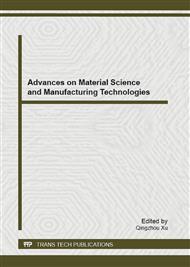[1]
Barial P, Quintela P. A numerical algorithm for prediction of thermomechanical deformation during the casting of aluminum alloy ingots. Finite Elements in Analysis and Design, 2000, 34: 125-143.
DOI: 10.1016/s0168-874x(99)00032-3
Google Scholar
[2]
Ohno A. Continuous Casting of Single Crystal Ingots by the O.C.C. Journal of Metals Process, 1986, 38: 14.
Google Scholar
[3]
Wang Y H, Kim Y J, Kou S. Thermal Measurement and Computer Modeling of Heat and Fluid Flow in Crystal Growth by Ohno Continuous Casting. Journal of Crystal Growth. 91(1-2) (1988)50-56.
DOI: 10.1016/0022-0248(88)90365-x
Google Scholar
[4]
0hno A. soda H. Development and application of OCC technology. International symposium on solidification Processing. Weinberg F.ed. The Metal Soc of CIM, Pergamum Press Inc, 1990, 215-225.
DOI: 10.1016/b978-0-08-040413-4.50025-7
Google Scholar
[5]
Soda H, Mclean G. Pilot-scale casting of single crystal copper wires by the Ohno continuous casting process.J Materials Science. 1995, 30: 5438-5 448.
DOI: 10.1007/bf00351555
Google Scholar
[6]
Xu Z M, Li J G, Fu H Z. Continuous casting technology of copper single crystal rod. Transactions of Nonferrous Metals Society of China, 1998, 8(2): 277-281.
Google Scholar
[7]
Huang H, Hill J L, Berry J T. A Free Thermal contraction method for modeling the heat transfer coefficient at the casting/mould interface. Cast Metals, 1994(4): 212-216
DOI: 10.1080/09534962.1992.11819115
Google Scholar
[8]
SENGUPTA J, MAIJER D M, WELLS M A, et a1. Mathematical modelling of the thermomechanical behavior of a 5r182 aluminum ingot during the startup phase of the IX: casting process: The role of bottom block[J]. Light Metals, 2001: 879-885.
Google Scholar
[9]
Tsunekawa M, Hayashi N, Uno T. Effects of various cooling conditions on the charactistic properties of aluminum DC ingots. Light Metal, 1996, 46(3): 132-137.
DOI: 10.2464/jilm.46.132
Google Scholar
[10]
Choudhay M, Szekdy J. Modeling of fluid and heat transfer in Industrial-Scale ERS system. Iron-making and Steelmaking, 1981, 8(5): 225-231.
Google Scholar
[11]
Drezet M, Rappaz M. Modeling of ingot distortions during direct chill casting of aluminum alloys. Metal Trans, 1996, 27A(10): 3214-3225.
DOI: 10.1007/bf02663872
Google Scholar
[12]
Engupta J, Maijer M, Wells A, et a1. Mathematical modeling of the thermomechanical behavior of a 5r182 aluminum ingot during the start-up phase of the IX:casting process:The role of bottom block. Light Metals, 2001: 879-885.
Google Scholar
[13]
Wang G. fast and robust variant of the SIMPLE algorithm for finite-element simulations of incompressible flows. Computational Fluid and Solid Mechanics, Elsevier, 2001, 2(4): 1014-1016.
DOI: 10.1016/b978-008043944-0/50828-3
Google Scholar


